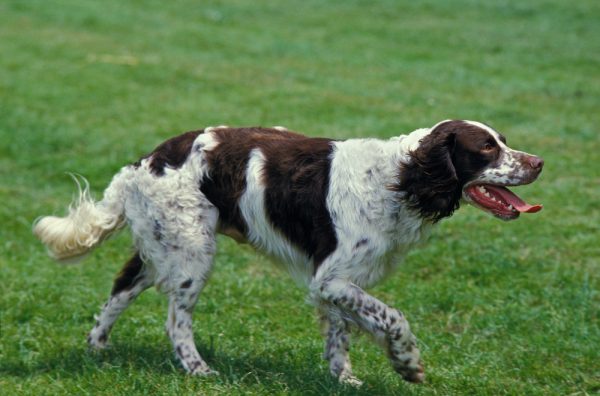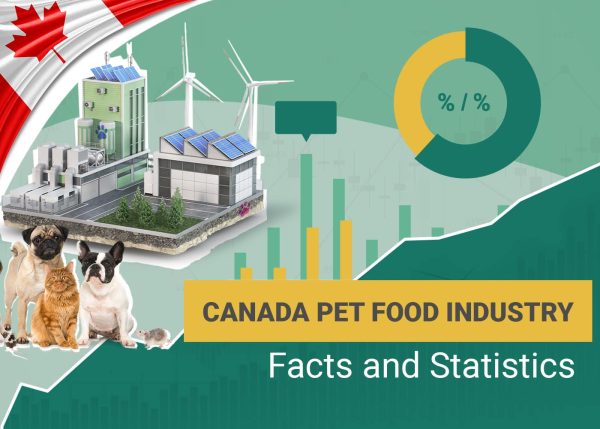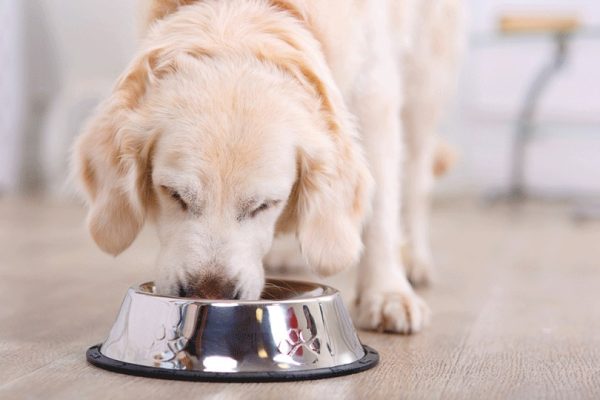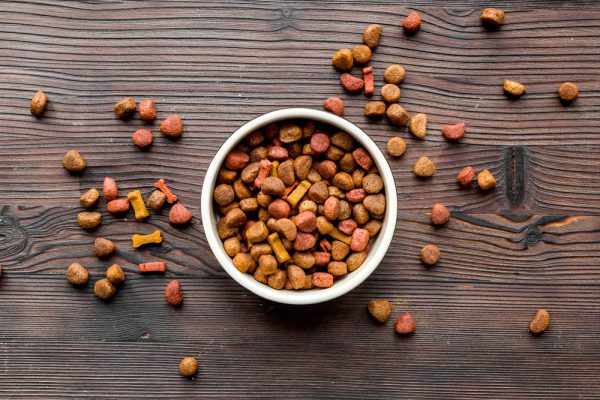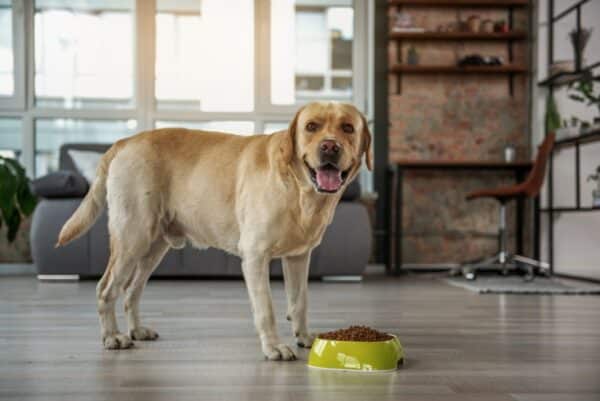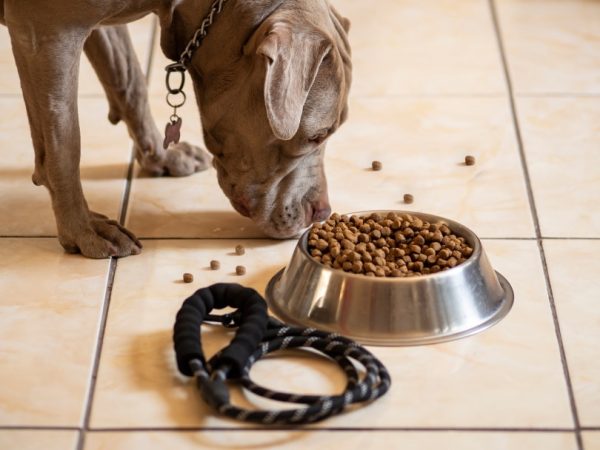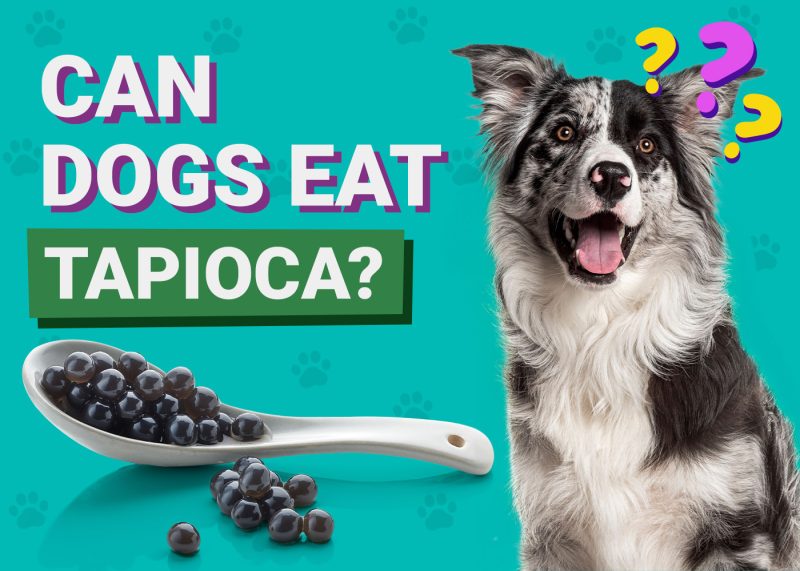
Finding a good high-fiber diet for dogs can be challenging due to the limited options and confusing different types of fiber, and we would always recommend consulting with a veterinarian to find the right option for your pup. To help you with your search, we’ve reviewed some of the most popular higher-fiber dog foods.
In this article

A Quick Look at Our Favorites of 2025
| Rating | Image | Product | Details | |
|---|---|---|---|---|
| Best Overall |
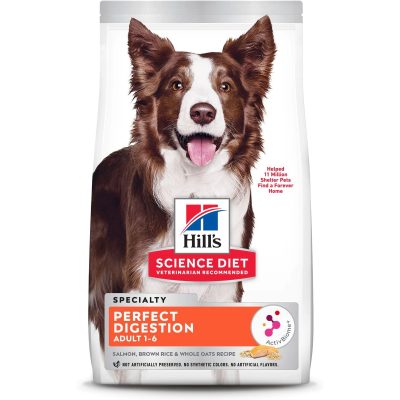
|
Hill’s Science Diet Adult Perfect Digestion Salmon Dry Dog Food |
|
Check Price |
| Best Value |
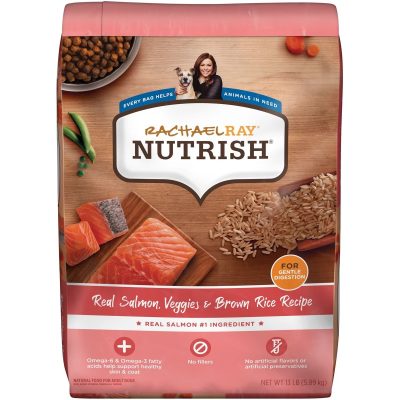
|
Rachel Ray Nutrish Real Salmon Gentle Digestion Dry Dog Food |
|
Check Price |
| Premium Choice |
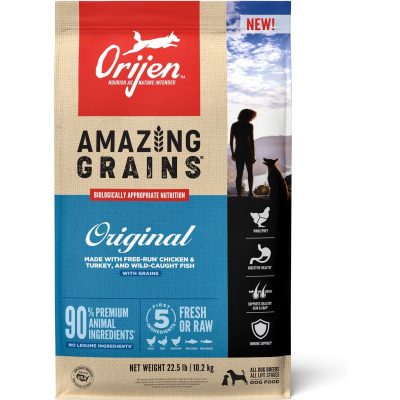
|
ORIJEN Amazing Grains Original Dry Dog Food |
|
Check Price |
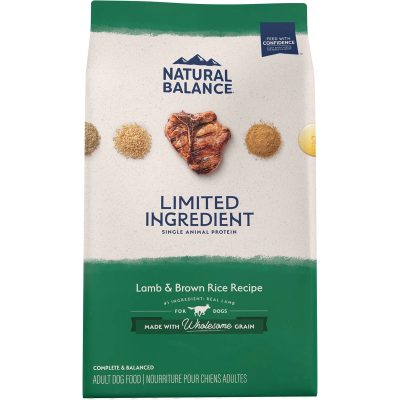
|
Natural Balance Limited Ingredient Lamb & Brown Rice Dry Dog Food |
|
Check Price | |
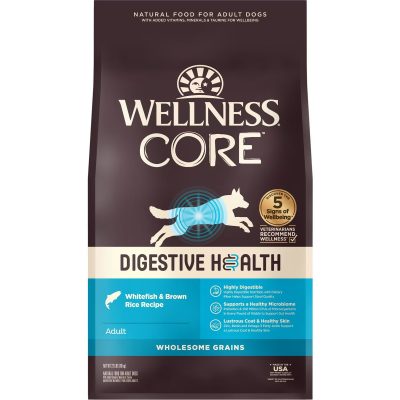
|
Wellness CORE Digestive Health Wholesome Grains Whitefish & Brown Rice |
|
Check Price |
The 9 Best High-Fiber Dog Foods
1. Hill’s Science Diet Adult Perfect Digestion Salmon Dry Dog Food – Best Overall

| Main ingredients: | Salmon, cracked pearl barley, whole grain oats, brown rice, whole grain corn |
| Protein content: | 20% min |
| Fat content: | 11% min |
| Fiber content: | 4% max |
| Calories: | 374 kcal/cup |
Hill’s Science Diet Adult Perfect Digestion Salmon Dry Dog Food was formulated by a team of veterinary experts to help dogs with digestive issues. When you look at the ingredient list and how meticulous the formula is, it’s no surprise that it’s the best overall high-fiber dog food. The first ingredient is salmon, which is an excellent source of omega-3 fatty acids. While omega-3 fatty acids are commonly known for improving the skin and coat, they can also help with diversifying the healthy bacteria in the gut.1
The other main ingredients in this dog food include a blend of nutritious, high-fiber grains, including cracked pearl barley, whole-grain oats, and brown rice. This formula also contains Hill’s Science Diet’s ActivBiome+ Technology blend of prebiotics, which helps cultivate a healthy gut biome and support healthy digestion. When following proper feeding guidelines, you can start to see improvements and healthier stools within 7 days.
The only thing to keep in mind is that this recipe does contain chicken meal. So, it’s not a viable option for dogs with chicken or poultry allergies.
- Salmon is first ingredient
- Contains nutritious blend of whole grains
- Supports healthy gut biome
- Can see results within 7 days
- Contains chicken
2. Rachel Ray Nutrish Dry Dog Food – Best Value
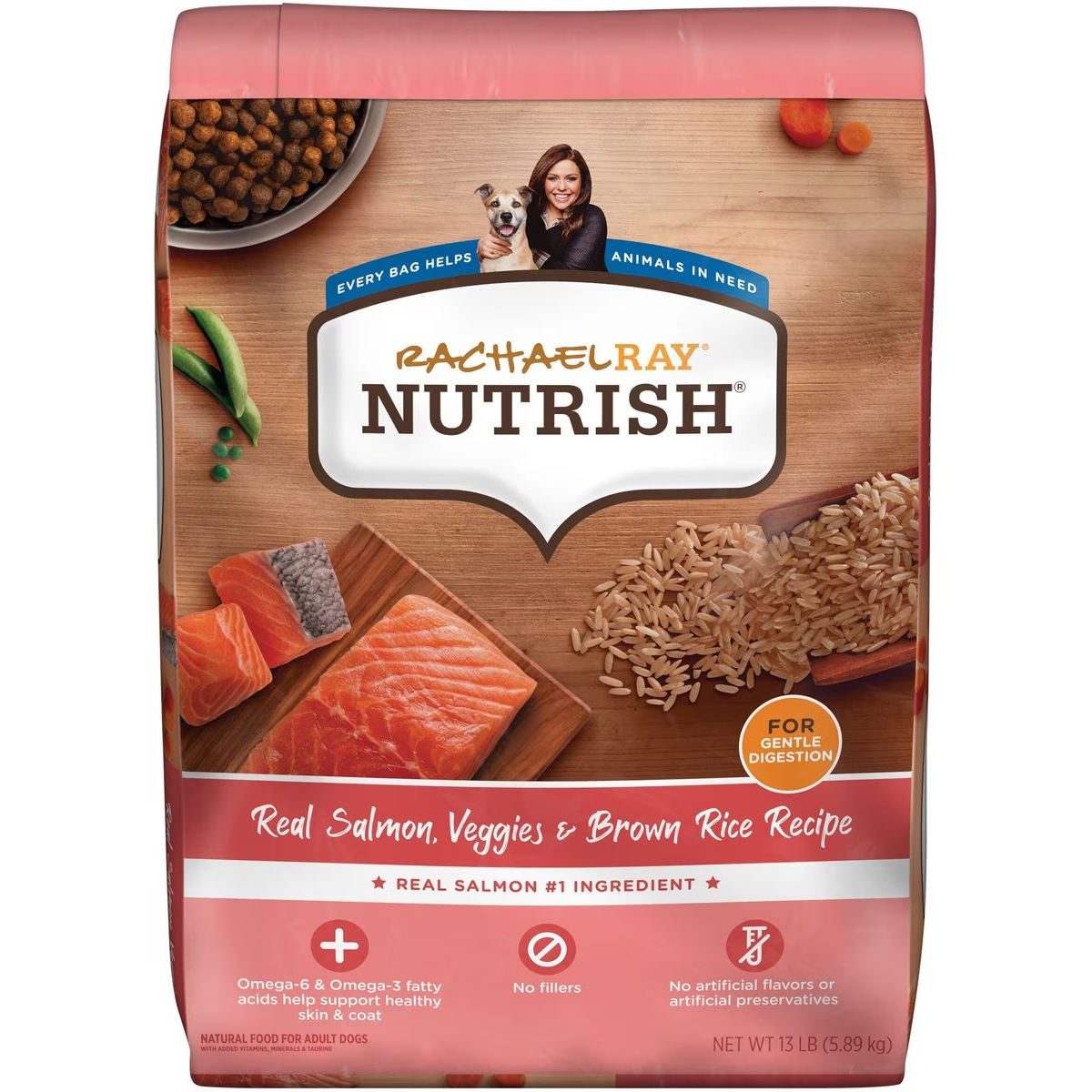
| Main ingredients: | Salmon, chicken meal, ground whole corn, dried peas, grain sorghum |
| Protein content: | 25% min |
| Fat content: | 14% min |
| Fiber content: | 4% max |
| Calories: | 335 kcal/cup |
Rachel Ray Nutrish Real Salmon, Veggies & Brown Rice Recipe Gentle Digestion Dry Dog Food is specifically made for dogs with sensitive stomachs in mind. The formula is designed to be gentle on the stomach, and the recipe contains natural sources of fiber, including grain sorghum, peas, and brown rice. It omits ambiguous ingredients, such as poultry by-product meals and artificial flavors, so that you know exactly what you’re feeding your dog.
Considering how this dog food has a relatively clean ingredient list for budget-friendly dog foods, it’s the best high-fiber dog food for the money. However, it’s still important to point out that one of the main ingredients is dried peas. More research still needs to be completed for definitive answers, but it’s possible that there could be a link between peas and diet-associated dilated cardiomyopathy (DCM). As with any dietary changes, it’s recommended to consult your veterinarian before switching to new dog food, especially if your dog’s breed is predisposed to genetic heart issues.
- Specifically formulated for sensitive stomachs
- Contains natural sources of fiber
- No ambiguous or artificial ingredients
- Peas are one of the main ingredients
3. ORIJEN Amazing Grains Original Dry Dog Food – Premium Choice
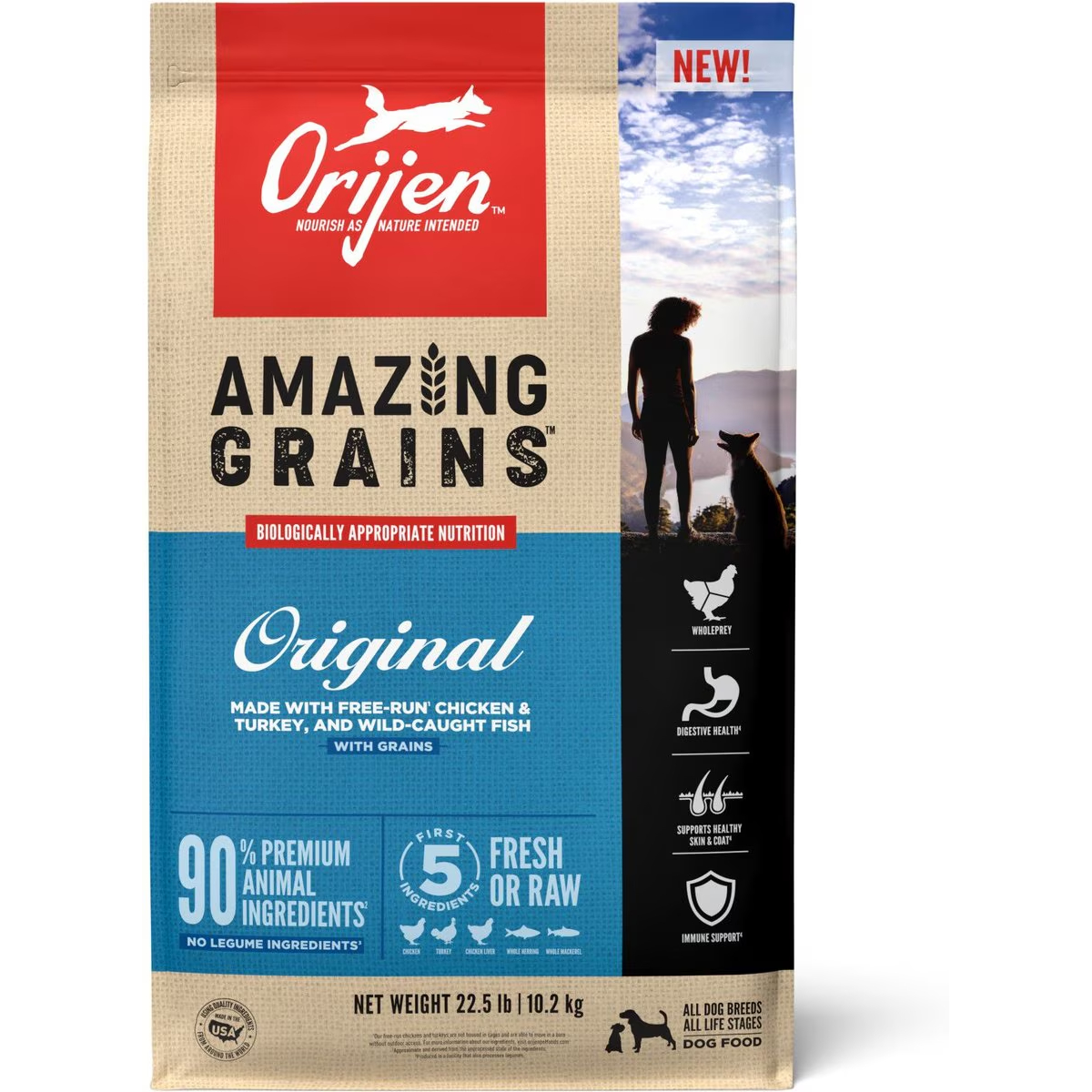
| Main ingredients: | Chicken, turkey, chicken liver, whole herring, dehydrated chicken |
| Protein content: | 38% min |
| Fat content: | 18% min |
| Fiber content: | 4% max |
| Calories: | 490 kcal/cup |
Most dogs won’t be able to resist eating ORIJEN Amazing Grains Original Dry Dog Food. It consists of 90% animal ingredients and contains a savory, palatable blend of high-quality proteins, including chicken, turkey, and whole herring. The kibble is also coated with a freeze-dried raw flavor, so even picky eaters usually enjoy eating it.
The formula is designed to target three main benefits: digestive health, immune support, and healthy skin and coat. It only uses premium whole grains sourced from non-GMO crops. Overall, this diet is an excellent choice for active dogs or working dogs that need an extra boost of energy, as it has a comparably higher amount of calories and protein. With that being said, it may contain too much protein for less active dogs and older dogs.
- Consists of 90% animal ingredients
- Palatable to picky eaters
- Supports digestive health, immune support, and skin and coat health
- May contain too much protein for some dogs
4. Natural Balance Limited Ingredient Dry Dog Food
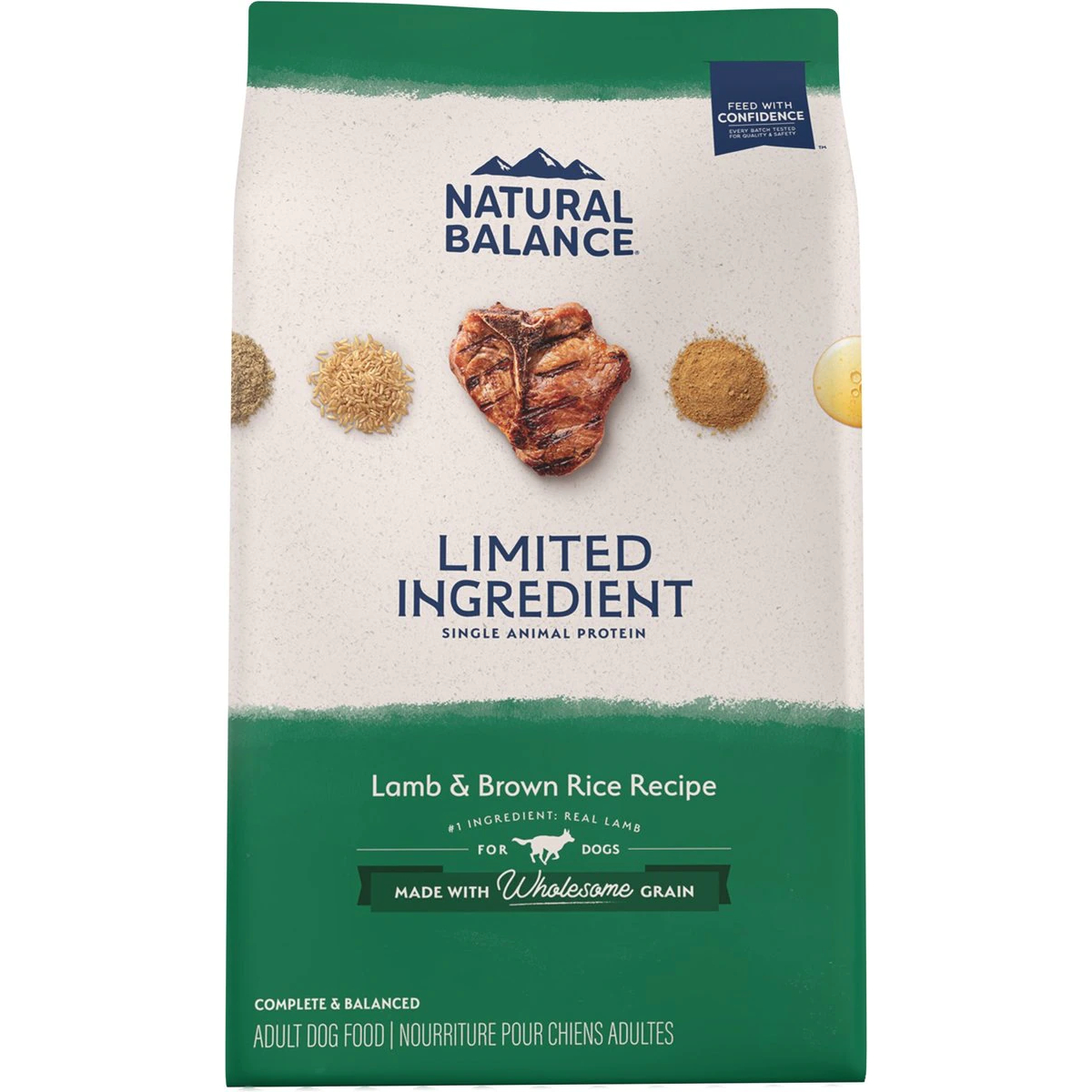
| Main ingredients: | Lamb, lamb meal, brown rice, brewer’s rice, rice bran |
| Protein content: | 22% min |
| Fat content: | 12% min |
| Fiber content: | 4% max |
| Calories: | 370 kcal/cup |
Natural Balance Limited Ingredient Lamb & Brown Rice Recipe can be an excellent option for dogs with digestive issues, allergies, and skin irritation. Lamb is the single source of animal meat, and it’s a novelty meat that most dogs with beef and chicken allergies can eat safely. The recipe also has a short and simple ingredient list that only contains the essentials for a healthy diet while boosting digestive health.
Along with supporting the digestive system, this dog food is designed to support heart health, immune health, and bone and joint health. So, even though it’s on the more expensive end, it’s still a good value when you consider its comprehensive, high-quality formula.
- Lamb is the single source of animal meat
- Limited ingredients for sensitive stomachs
- Supports multiple areas of bodily functioning
- Relatively expensive
5. Wellness CORE Digestive Health Wholesome Grains Dog Food
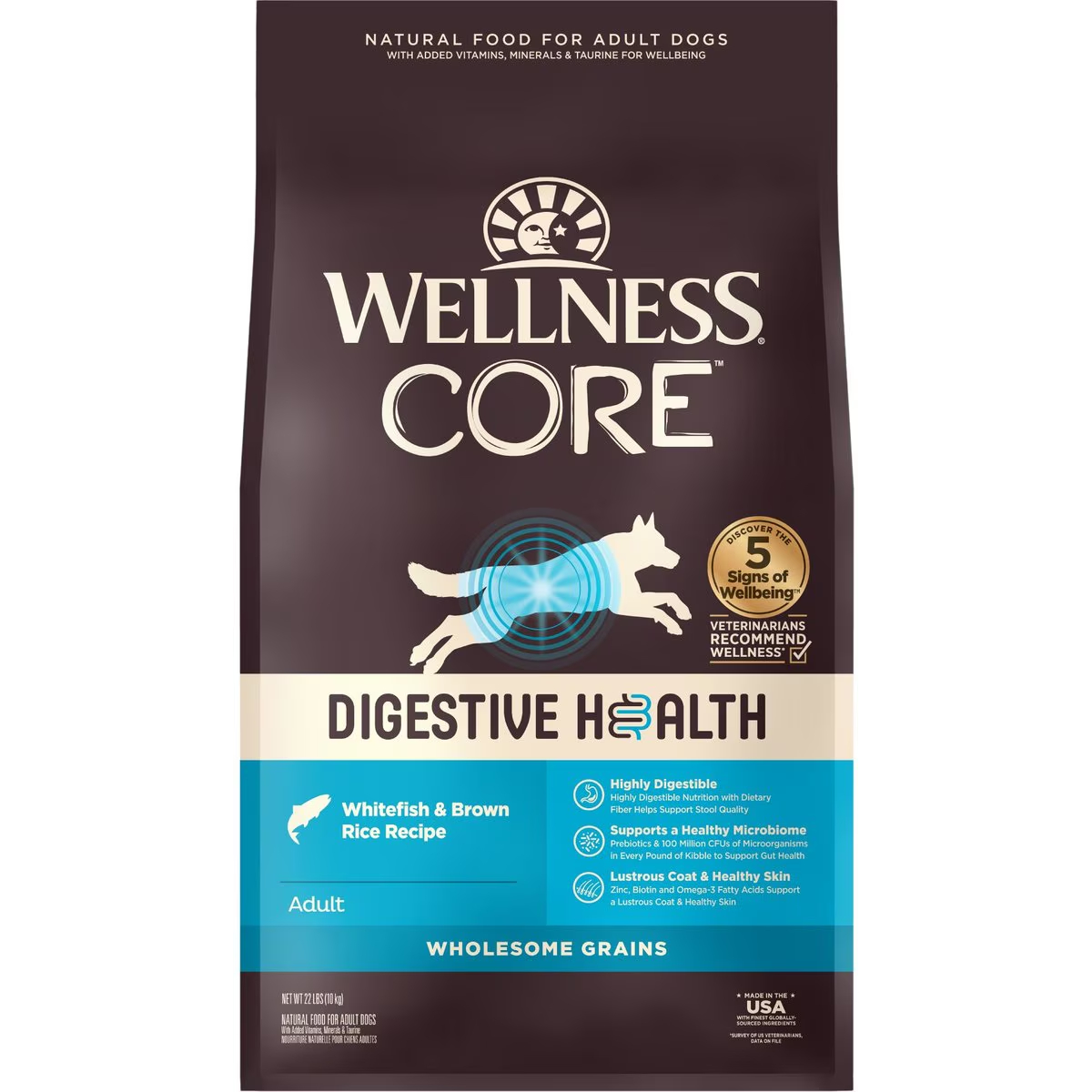
| Main ingredients: | Whitefish, menhaden fish meal, herring meal, brown rice, oat groats |
| Protein content: | 30% min |
| Fat content: | 12% min |
| Fiber content: | 4% max |
| Calories: | 394 kcal/cup |
Wellness CORE Digestive Health Wholesome Grains Whitefish & Brown Rice Recipe Dry Dog Food is another excellent option for dogs allergic to beef or chicken. The only animal protein used in this dog food is fish, with whitefish being the first ingredient. The recipe is specifically designed to support healthy digestion and contains natural sources of fiber. The kibble is coated with a probiotic coating that consists of digestive enzymes, prebiotic fibers, and probiotics to boost your dog’s gut health. You’ll also find natural ingredients that are nutritious, easily digestible, and gentle on the stomach.
This dog food is formulated for adult dogs of all ages. However, older dogs with weaker teeth or dental issues may have difficulty eating it. A common customer concern is that the kibble can be too hard for their dog to chew easily.
- Fish is the single source of animal protein
- Probiotic coating aids digestion
- Uses easily digestible ingredients
- Kibble may be too hard and difficult to chew
6. Purina Pro Plan Adult Weight Management Dog Food
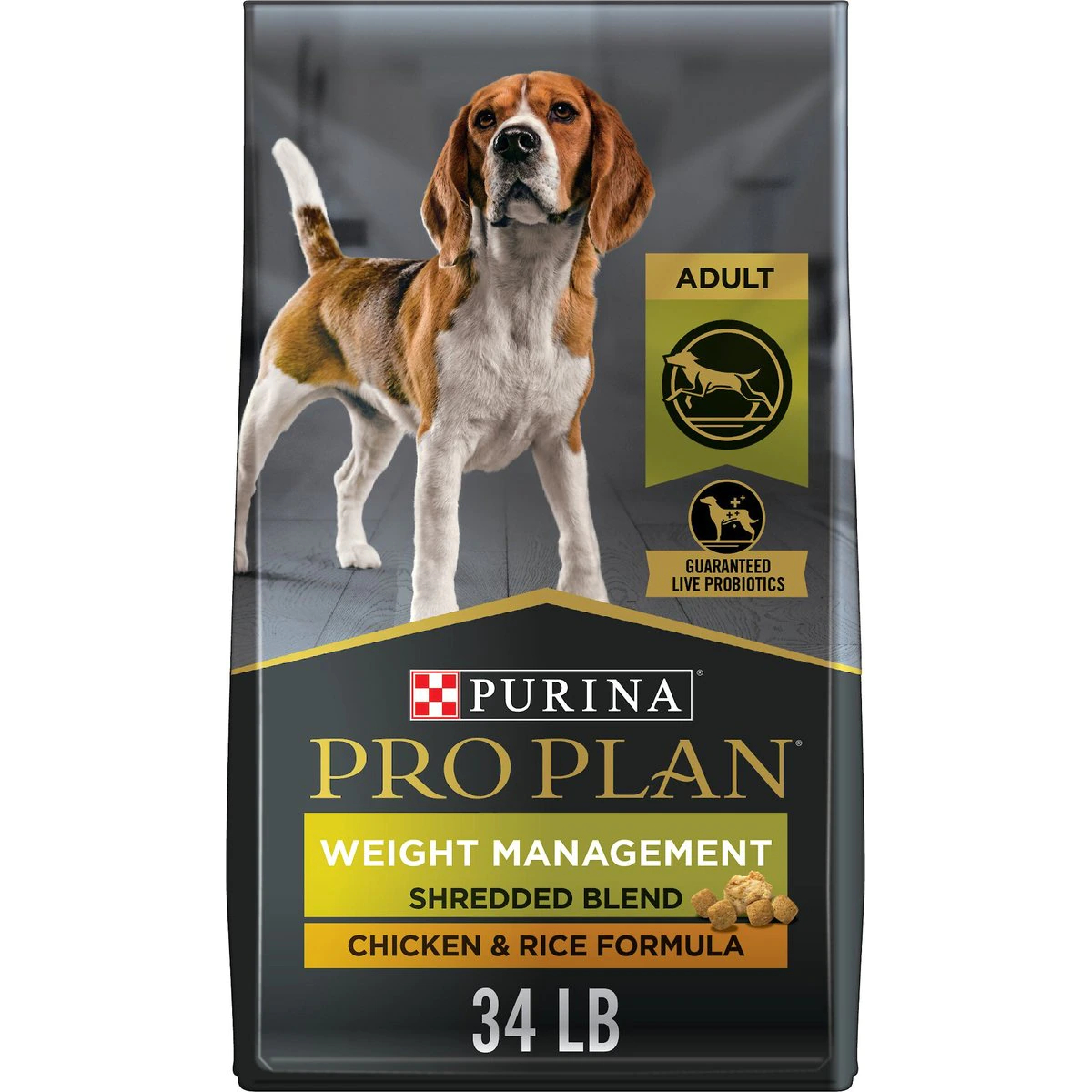
| Main ingredients: | Chicken, rice, whole grain corn, poultry by-product meal |
| Protein content: | 27% min |
| Fat content: | 9% min |
| Fiber content: | 5.5% max |
| Calories: | 330 kcal/cup |
Purina Pro Plan Adult Weight Management Shredded Blend Chicken & Rice Formula Dry Dog Food is a viable option for dogs that are working on shedding some weight. Selecting a diet that has a healthy amount of fiber can help overweight dogs lose weight by making them feel fuller for longer. This recipe contains prebiotic fiber sourced from wheat bran that nourishes healthy bacteria found in the intestinal tract. It also has live probiotics to further aid healthy digestion.
The recipe lists chicken as its first ingredient and has an optimized protein-to-fat ratio to help dogs continue to maintain healthy muscle mass while they’re managing their weight. Overall, it’s a meal with 100% complete and balanced nutrition for adult dogs. However, it does contain poultry by-product meal, which may not be the best option for some dogs with food sensitivities.
- Contains prebiotics and probiotics
- Optimized protein-to-fat ratio for healthy weight loss
- Chicken is the first ingredient
- Contains poultry by-product meal
7. Blue Buffalo Life Protection Formula Healthy Weight Dog Food
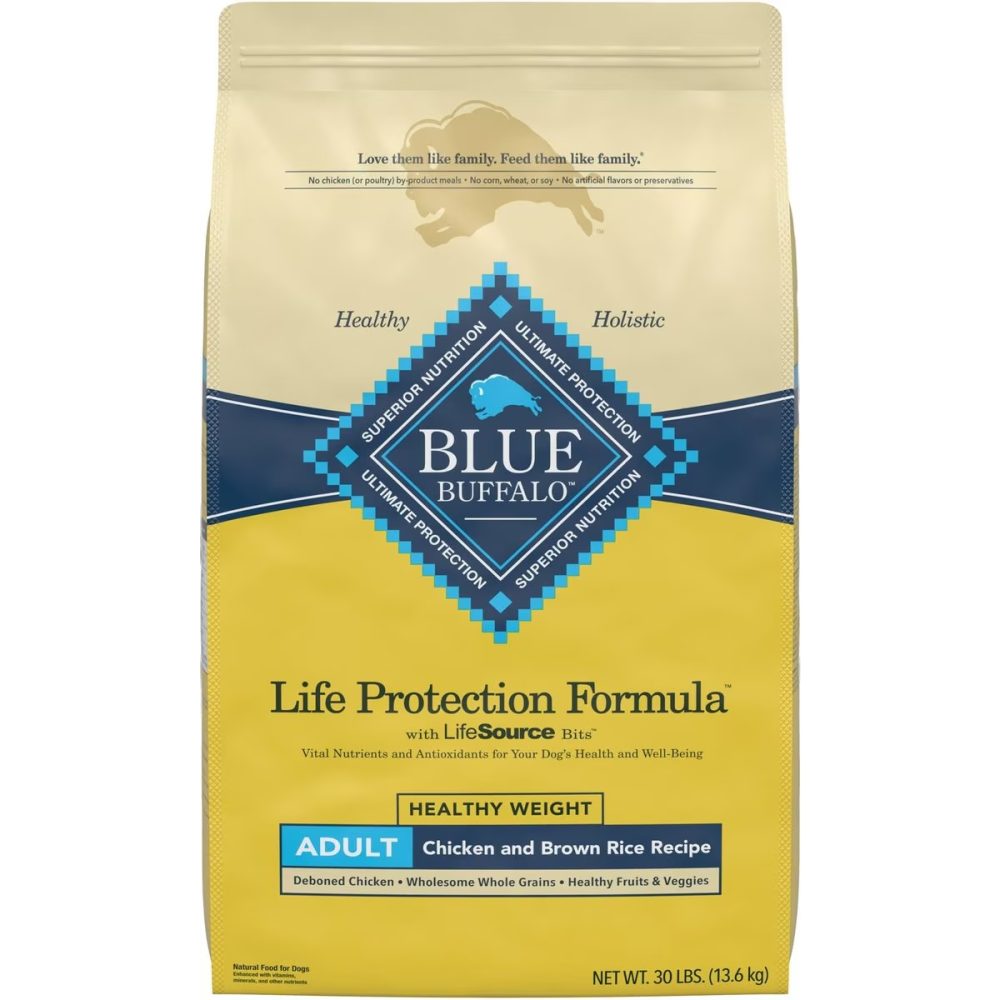
| Main ingredients: | Deboned chicken, chicken meal, brown rice, barley, oatmeal |
| Protein content: | 20% min |
| Fat content: | 9% min |
| Fiber content: | 10% max |
| Calories: | 324 kcal/cup |
Blue Buffalo Life Protection Formula Healthy Weight Adult Chicken & Brown Rice Recipe Dry Dog Food is another diet specifically formulated for weight management. It’s a low-calorie diet that uses high-quality, natural ingredients to ensure your dog experiences healthy weight loss. It lists deboned chicken as its first ingredient and contains L-carnitine, which helps with lean muscle development while lowering calories from fat.
The recipe also incorporates multiple natural and nutritious sources of fiber, including brown rice, barley, flaxseed, and oatmeal. It’s fortified with Blue Buffalo’s Super 7 Package of Antioxidant-Rich Ingredients to support other bodily functions, such as joint health and immune health.
Most dogs find this recipe highly palatable. However, it has a bit of a crumbly texture, and the kibble must be scooped gently to prevent a pile of crumbs forming at the bottom of the bag.
- Low-calorie diet
- Contains natural sources of fiber
- Contains antioxidant-rich ingredients
- Tends to have a crumbly texture
8. ACANA Singles + Wholesome Grains Limited Ingredient Diet Dog Food
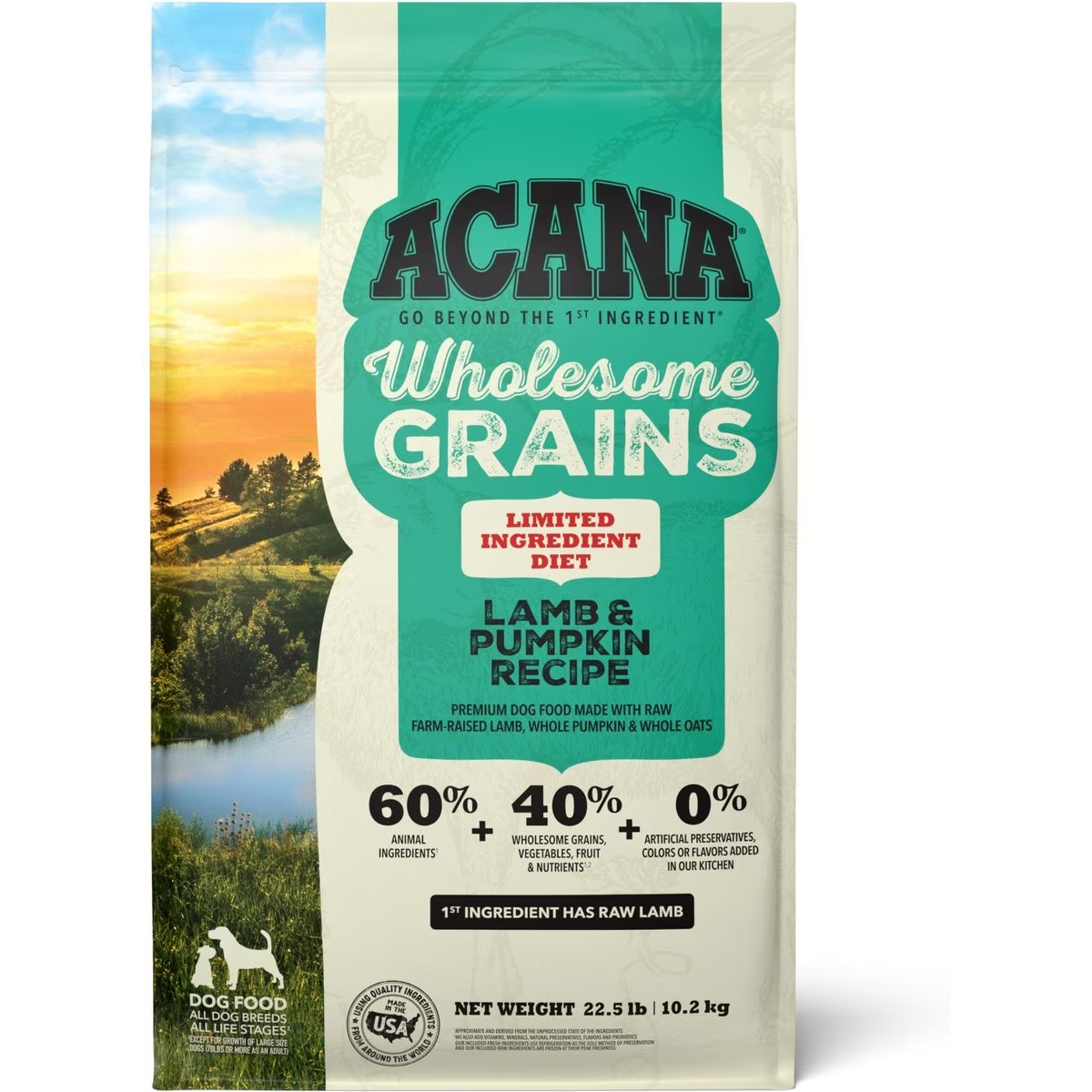
| Main ingredients: | Lamb, lamb meal, oat groats, whole sorghum, lamb liver |
| Protein content: | 27% min |
| Fat content: | 17% min |
| Fiber content: | 6% max |
| Calories: | 371 kcal/cup |
ACANA Singles + Wholesome Grains Limited Ingredient Diet Lamb & Pumpkin Recipe Dry Dog Food is a high-quality diet that’s specifically designed for easy digestion. Even though it’s one of the more expensive dog foods on our list, it’s still a great value when you consider all its benefits.
This limited-ingredient diet only uses novelty meat and is free of common allergens like beef and chicken. It’s rich in fiber, prebiotics, and probiotics to revitalize and support gut health. The use of wholesome grains, pumpkin, and squash helps dogs digest this food easily and feel fuller for longer. It also contains natural sources of omega-3 and omega-6 fatty acids to support the digestive system and skin and coat health.
This dog food consists of 60% animal ingredients and lists lamb and lamb meal as its first two ingredients. Considering these factors, it’s no surprise that this recipe has a strong, gamey smell. Most dogs don’t mind, but it can be overpowering for humans. So, it’s important to store it in a tightly sealed container to keep smells at bay.
- Designed for easy digestion
- Uses a single source of animal protein
- Contains a blend of fiber, prebiotics, and probiotics
- Relatively expensive
- Has a strong gamey smell
9. Royal Canin Veterinary Diet Adult Gastrointestinal High-Fiber Dry Dog Food
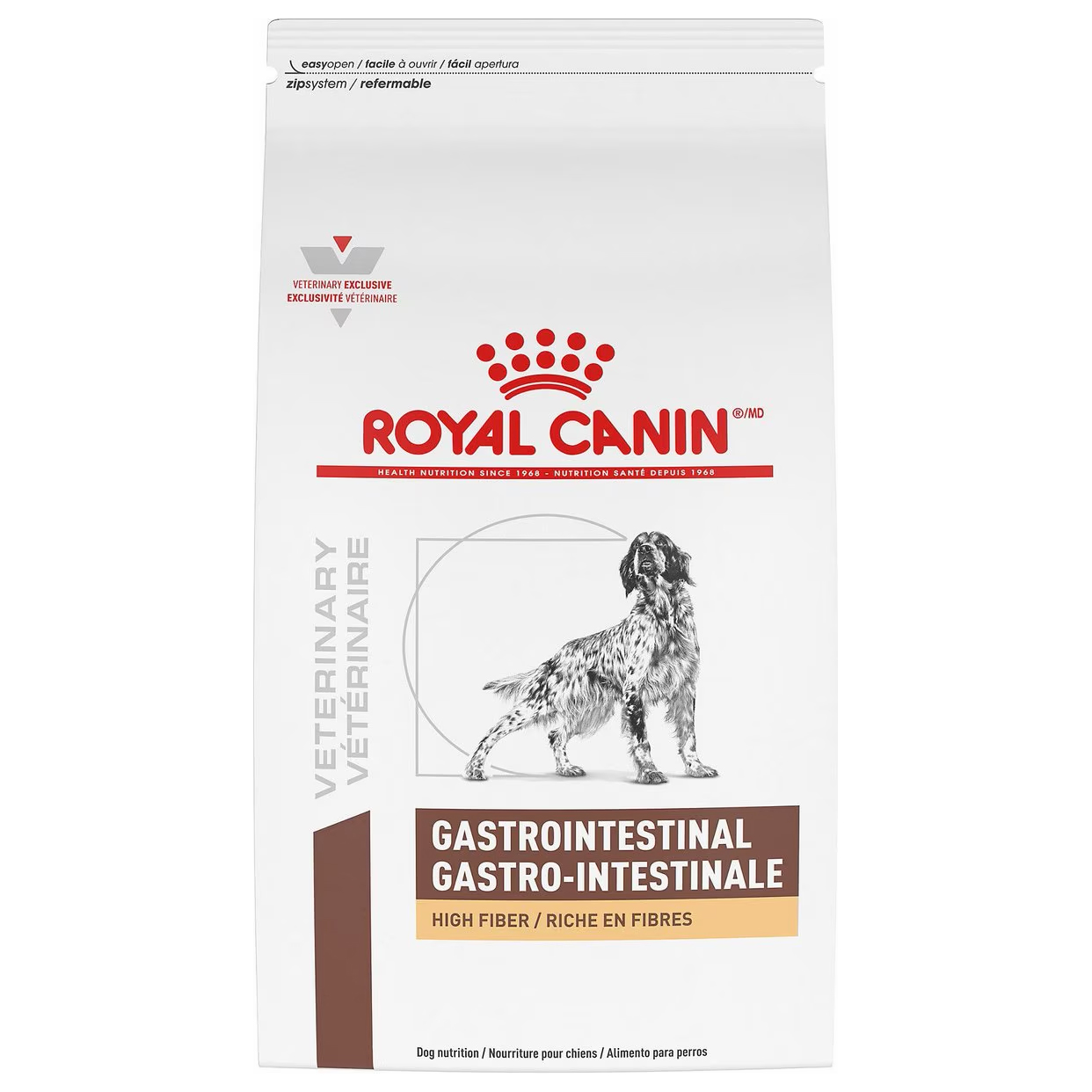
| Main ingredients: | Chicken by-product meal, brewer’s rice, pea fiber, chicken fat, wheat |
| Protein content: | 21% min |
| Fat content: | 14% min |
| Fiber content: | 13.3% max (7.9% min) |
| Calories: | 290 kcal/cup |
Royal Canin Veterinary Diet Adult Gastrointestinal High Fiber Dry Dog Food is a veterinary diet designed to support digestive health and regulate stool frequency and quality. It does require veterinarian authorization, which means that it’s not readily available to everyone.
This dog food contains prebiotic fibers that help support gut health and less fermented fibers to improve stool quality. It also contains omega-3 fatty acids and highly digestible proteins to provide even more support to the digestive system. However, this recipe uses chicken by-product meal and pea fiber as some of its main ingredients. So, it’s important to consult your veterinarian to see if this diet is appropriate and beneficial for your dog.
- Contains a blend of fibers to aid digestion
- Improves stool quality
- Uses highly digestible protein sources
- Chicken by-product meal and pea fiber are main ingredients
- Requires veterinary prescription

Buyer’s Guide: Choosing the Best High-Fiber Dog Food
Before choosing a high-fiber diet, it’s important to consult a veterinarian to determine whether it’s an appropriate diet for your dog. Different types of fiber will produce different results, so which diet you choose will depend on any health issues your dog suffers from and your reasons for feeding it. As is often the case, you can have too much of a good thing! Excess dietary fiber can decrease the digestibility of other important nutrients. High-quality dog food manufacturers will take this into account when formulating recipes.
Here are some things to be aware of when shopping for high-fiber dog food.
Fiber Percentage
All dog food will have a guaranteed analysis on its packaging. The guaranteed analysis lists the maximum level of crude fiber. Crude fiber includes the amount of insoluble fiber but not the soluble fiber (more on this below); also, as the level lists the maximum level, the actual crude fiber amount could be much lower. Total dietary fiber (TDF) is a more accurate way of measuring the amount of fiber in foods, but it is rarely available in commercial pet foods except for some prescription foods.
This can unfortunately make choosing a high-fiber food purely based on the fiber percentage on the label quite difficult and confusing. Most dog food will contain anywhere from 2.5% to 4.5% crude fiber. Specialty diets and veterinary diets may contain 9% to 10%. Every dog is unique in their nutritional needs, so we recommend reaching out to a vet for advice.
If you need to speak with a vet but can't get to one, head over to PangoVet. It's an online service where you can talk to a vet online and get the personalized advice you need for your pet — all at an affordable price!

Different Types of Fiber
- Insoluble fibers: This type of fiber does not dissolve in water and enters and exits the body unchanged. Insoluble fibers tend to keep your dog’s digestive system moving and regular and help prevent constipation. It can also increase the volume of the feces, and more bulky stools can help empty anal glands during defecation. Cellulose and brown rice are examples of insoluble fiber. Weight management and prescription weight loss diets often contain higher amounts of insoluble fiber as it adds bulk to the diet without calories. It can help dogs feel fuller for longer after a meal. It’s important to make sure high-fiber foods are nutritionally balanced for your dog’s life stage.
- Soluble fibers: This type of fiber usually slows digestion and pulls water into the gut. Fermentable soluble fibers can also be ‘prebiotic fibers’ because they feed the good bacteria that live in the gut. This supports the growth of beneficial bacteria in the colon and can help alleviate symptoms of gastrointestinal upset.
Our Selection Process For High-Fiber Dog Foods
To create this buyer’s guide, our writing team and editorial staff checked customer reviews, brand reputation, and veterinary approval ratings to present the dog foods we think should be highlighted for our readers. In some cases, we conducted hands-on testing along with seeing how much our dogs liked the dog foods. All these factors were considered when selecting these listed dog foods to help you make the best purchase for your furry friends.
Why Trust Dogster?
Since 2004, Dogster has been a trusted brand for dog owners online, which means we have a lot of experience with dog foods. We take pride in promoting the well-being of all dogs—from toy breeds to giant canines. Our in-house veterinarians, writers, and editors examine each product on our lists, ensuring its quality and reputation. As pet owners ourselves, we only want the best for our furry companions. At Dogster, we are transparent about the products we promote. The nutritional information, overall brand reputation, and customer reviews are all considered for these lists. We inform you how we want to be informed.

Conclusion
According to our reviews, Hill’s Science Diet Adult Perfect Digestion Salmon Dry Dog Food is the best high-fiber dog food because of its high-quality blend of fiber and prebiotics that support gut health and digestion. Rachel Ray Nutrish Real Salmon, Veggies & Brown Rice Recipe Gentle Digestion Dry Dog Food is a considerable budget-friendly option, while ORIJEN Amazing Grains Original Dry Dog Food is a premium option that’s worth every penny.
Natural Balance Limited Ingredient Lamb & Brown Rice Recipe can be a great choice for dogs with certain food allergies and digestive issues.
Featured Image Credit: Maximilian100, Shutterstock





